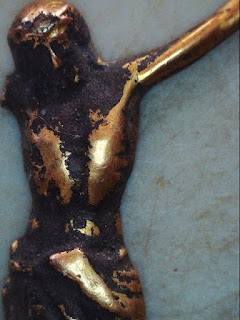Written by the TreasureGuide for the exclusive use of the Treasure Beaches Report.
 |
| Gold Christ Figure Found On Treasure Coast Beach. |
Today I'm going to show you what I learned about cleaning gold items. In particular I am talking about the Christ figure shown above. I've shown it several times before. It was found many years ago at John Brooks beach. When I found it I thought it must be plated or something because it looked like some of the plating was worn off. After inspecting the item many years later under a microscope I could see that there was some type of encrustation over the gold. It was not the surface being worn away at all, but that was not apparent until I looked at it with my microscope.
You'll often hear that gold comes up looking brand like it is brand new. In fact the TAMU conservation lab web site has the following.
GOLD CORROSION
Gold is a relatively inert metal and thus undergoes minimum corrosion. It is the copper- and/or silver-based gold alloys that easily corrode, resulting in silver or copper corrosion compounds that leave an enriched and possibly weakened gold surface.
GOLD CONSERVATION
Pure gold and high gold alloys do not require any conservation treatment. Gold objects from shipwreck sites appear to look the same when recovered as the day they went down with the ship. The copper and silver in low- alloy gold do corrode. When present, the copper and/or silver corrosion compounds of low-alloy gold are treated by the processes described for these two metals (see Files 12 and 13). Silver corrosion products can be removed with ammonia; copper compounds with formic acid, citric acid, or alkaline sequestering agents, such as Rochelle salts or alkaline glycerol. All the pertinent comments applicable to silver and copper conservation are made under those headings.
But what we are dealing with here is a layer of encrustation over the gold, not corrosion of the gold or its alloys.
Last fall I found two encrusted gold rings. I showed them before too. Here are those two encrusted rings as found.
 |
| Two Encrusted Gold Rings. |
The encrustation on these rings looked very much like the hard concreted material where they were found. Here is another view of one of them.
 |
| Encrusted Gold Ring. |
I cleaned those rings, and here is what they looked like with most of the encrustation removed.
 |
| Partially Cleaned Gold Rings. |
 |
| Relatively Clean Back of Feet. |
 |
| Feet (front) Before Cleaning. |
A coin collector on a numismatic forum said: If your gold is well mixed alloy (think modern gold coins) it is pretty much impervious to any solvent except aqua regia.
Older gold if it still retains it's original skin carries some risk, especially if copper spots are present. But that risk is minimal.
If you have pristine Brasher Dubloons, gem Sesqui slugs, or Cameo Proof Libs, then find someone with mucho experience.
All else-- the reward factor will often exceed the risk factor.
Being very cautious, I decided to try a little acetone, following by a some light wiping with a cloth (left) first. The pictures below show the item uncleaned first (left), and then the second picture (center) shows the item after a light cleaning using aceotone. As you can see, a small amount of the encrustation was removed by the acetone.
 |
| Foot of Gold Figure Before Cleaning (left), After Acetone (center), and After Vinegar (right). |
After that I decided to try a short soak in a little white vinegar (5% acid).
The third picture shows the same item after a couple of hours soaking in vinegar. After the soaking it was lightly rubbed with a cloth. As you can see, more of the crust was removed this time, but still a little very stubborn crust remains.
It very apparent that the crust is on the surface and the underlying gold is in good condition.
So my conclusion to this point is that acetone worked a little, as did the vinegar.
I've seen crusts on objects that totally resisted strong solutions of Muriatic acid. It depends on what the crust is made of.
Both the rings and Christ figure were found just below the low tide shallow water where there was what I would call mud rock.
I hope to clean the entire Christ figure in the future. I'm being very cautious. I'll report on my progress.
---
Scientists have long struggled to solve the puzzle of the gearing system on the front of the so-called Antikythera—a fragmentary ancient Greek astronomical calculator, perhaps the earliest example of a geared device. Now, an interdisciplinary team at University College London (UCL) has come up with a computational model that reveals a dazzling display of the ancient Greek cosmos, according to a new paper published in the journal Scientific Reports. The team is currently building a replica mechanism, moving gears and all, using modern machinery. You can watch an extensive 11-minute video about the project here (embedding currently disabled)...
Scientists solve another piece of the puzzling Antikythera mechanism | Ars Technica
---
Tomorrow I'll show finds made by Michael T.
It looks like next weekend we might get some more rough surf.
 |
| Source: MagicSeaWeed.com. |
It is too early to have a lot of confidence in that prediction, but maybe it will happen.
Keep watching.
TreasureGuide@comcast.net